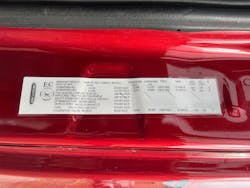Match load to tire inflation pressure
The most common misconception about load and inflation pressure is the myth that the maximum pressure molded on the sidewall of the tire is necessary to carry the weight of the vehicle. Although that may be true in isolated applications, in most instances a lower inflation is sufficient. To determine the load rating of tires, start with the federal regulation governing motor vehicles with a gross vehicle weight rating (GVWR) of more than 10,000 pounds.
According to 49 CFR 571.120, “the sum of the maximum load ratings of the tires fitted to an axle shall be not less than the gross axle weight rating (GAWR) of the axle system as specified on the vehicle’s certification label required by 49 CFR part 567.”There are some exceptions, but 571.120 applies to almost every commercial motor vehicle in use today.
One of the most popular tire sizes for trucks and trailers is the 295/75R22.5 with a Load Range G, which has a maximum single load of 6,175 pounds at 110 psi and a maximum dual load of 5,675 pounds at the same inflation pressure.
Read also: Keep tire techs safe
If the GAWR on the front axle of a truck is 12,350 pounds, then the combined capacity of both steer tires must meet or exceed that specification. When the tires are installed on steer positions, the full inflation pressure is not necessary to comply with 571.120. The GAWR on the front axle is 12,350 pounds, so both steer tires must have a combined carrying capacity of at least 12,350 pounds, but the inflation pressure can be less than the maximum depending on the load.
Drive and trailer tire inflation
Drive and trailer axles are more complicated. According to 23 CFR 658.17, “the maximum gross weight upon any one axle, including any one axle or a group of axles, or a vehicle is 20,000 pounds” and “the maximum gross weight on tandem axles is 34,000 pounds.” This applies to the National System of Interstate and Defense Highways, but individual states set their own limits, which cannot be less than the federal guidelines. As a result, several states have different maximum weights for single and tandem axles that are higher than those established by 658.17.
For the 295/75R22.5 Load Range G, the maximum capacity in a dual application is 5,675 pounds at 110 psi, which translates to 22,700 pounds across the axle. At maximum inflation pressure, the tires will have 2,700 pounds of additional carrying capacity on a drive or trailer axle with a GAWR of 20,000 pounds. The same tires will actually carry 5,070 pounds at 95 psi, so the maximum inflation pressure is not necessary in order to carry the GAWR.
No one disputes the effects of under-inflation on tread wear and tire life. With insufficient inflation pressure for the load, higher costs result as tires experience irregular tread wear or fail during operation. Yet overinflation can have a similar effect on tread wear and tire life. Irregular wear patterns can be the result of too much inflation pressure for the load, and the lack of deflection in the sidewalls increases the chances for an impact break.
Inflating the tire to the load provides the best conditions for optimal tread wear, but it also requires a higher level of maintenance. At 95 psi, the 295/75R22.5 Load Range G will have the capacity to support the maximum load on a 20,000 pound axle. The loss of just 5 psi, however, lowers the dual tire load limit to 4,885 pounds, which translates to 19,540 pounds for the axle.
There is a big difference between the capacity requirements in 571.120 and the actual inflation pressure in the tires. Compliance is simple math to ensure that the tires can support the GAWR. The best practice is to consult the tire manufacturer or commercial tire dealer to determine the inflation pressure that works best for each application regardless of what it says on the sidewall.
--This article originally appeared in Fleet Owner.
About the Author
Kevin Rohlwing
SVP of Training, Tire Industry Association
Kevin Rohlwing is the SVP of training for the Tire Industry Association. He has more than 40 years of experience in the tire industry and has created programs to help train more than 180,000 technicians.
The Tire Industry Association (TIA), established in 1921, is international nonprofit association representing all segments of the tire industry, including companies that manufacture, repair, recycle, sell, service or use new or retreaded tires, and also those suppliers or individuals who furnish equipment, material or services to the industry. TIA is the leading advocate as well as instructor in technical training of tire service technicians.
